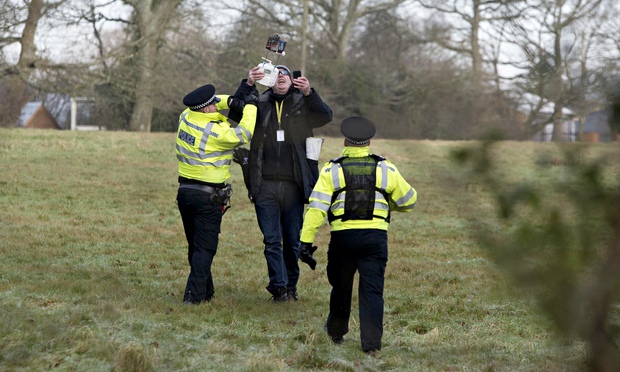
Robohub.org
The Drone Center’s Weekly Roundup: 1/5/15

A photojournalist was arrested in England for flying a drone, but was later released without charge. Credit: Darren Cool
News
The U.S. Department of Defense confirmed in a statement that it had carried out an airstrike in Somalia,killing Abdishakur, the chief of intelligence for al-Shabab. The strike, which is thought to have been carried out by a drone, targeted a convoy of vehicles in the vicinity of Saakow, Somalia. One other al-Shabab militant is believed to have been killed. (Reuters)
In Pakistan, a U.S. drone strike reportedly killed six people in the tribal region of North Waziristan. According to an unnamed Pakistani government official who spoke with the New York Times, the strike targeted the compound of Usman, an Uzbek Taliban leader. It remains unclear if Usman was killed in the attack.
The U.S. Air Force’s drone operators are at “breaking point,” according to an internal memo obtained by The Daily Beast. According to the memo and several USAF sources, the Air Force doesn’t have enough pilots and operators to meet the Pentagon’s demands for surveillance flights, which have increased as a result of the fight against ISIS. Not only are overworked crews leaving the Air Force, the service has been forced to suspend training for many pilots in order to staff the rising number of patrols.
The U.S. Federal Aviation Administration missed a deadline to release regulations for hobbyist and commercial drones. In October, when the FAA turned in a draft of the rules to the White House, the FAA said that it expected the rules to be published by the end of the year. The rules must be reviewed by the White House Office of Management and Budget before going into effect. (Reuters)
The FAA will allow the Florida Keys Mosquito Control District to use drones to monitor mosquito populations. The District will fly two unmanned aircraft over an area of Monroe County, Florida, where some species of mosquito are known to carry diseases such as dengue and malaria. (Fox News Latino)
The FAA is investigating at least 20 incidents of drone sightings that have taken place in the Washington, D.C. area over past few months. Several drones have been spotted flying near Reagan National and Dulles International airports. In other cases, hobbyists have been spotted flying around popular D.C. tourist destinations and sports stadiums. (NBC4 Washington)
The Civil Aviation Authority of the Philippines has issued regulations for aerial drones. Under the regulations, drone operators are prohibited from flying above 400 feet or near airports, and will be required to obtain approval from the CAAP before flying over populated areas.
Police in England arrested a photojournalist while he was flying his drone above the scene of a caravan fire that killed three people. Eddie Mitchell, a licensed drone operator, was flying in an area within the airspace of Gatwick International Airport, though outside of the no-fly zone immediately surrounding the airport. He was released without charge. (Forbes)
Energy companies in the United Kingdom are worried that hobbyist drones could crash into power lines and damage the National Grid. “If one of them strikes a power line or crashes into a substation, it can potentially damage an important piece of equipment and cause a power cut,” Rodney Grubb, the head of Scottish and Southern Hydro Electric Power Distribution, told the Independent.
Ehang, a drone startup, raised $10 million in Series A funding. The company, which is based in Beijing and San Francisco, makes the Ghost Drone, an aircraft that can be controlled using a smartphone. (VentureBeat)
Commentary, Analysis and Art
At Popular Mechanics, Joe Pappalardo warns that Iran’s recently unveiled “suicide drone” could cause serious damage.
Cryptome posted a series of satellite photos that appear to show the expansion of Chabelley Air Base, a station for U.S. drones in Djibouti.
At Defense One, Patrick Tucker predicts that 2015 will be a big year for artificial intelligence in the U.S. military.
At ArchDaily, Evan Rawn examines how drones could provide a new aerial vantage point for city planners.
At the Navy Times, Meghann Myers predicts that in 2015 the X-47B and Triton drones could set milestones in the history of naval aviation.
At Geographical Imaginations, Derek Gregory reviews Kill Chain: Drones and the Rise of High-Tech Assassins, a forthcoming book by Andrew Cockburn.
A special edition of the Journal of Strategic Studies was dedicated to studying the “challenges in drone geopolitics.”
At the Smithsonian’s Air and Space Museum Blog, Roger Connor advises recipients of holiday drones on how to fly drones safely.
At War is Boring, David Axe reports that the U.S. spy plane fleet, which includes several unmanned platforms,recorded 1,000 hours of surveillance video per day in 2012.
Know Your Drone
ComQuest Ventures, a small drone maker, has unveiled a hobby drone model capable of both vertical takeoff and landing (VTOL) and fixed-wing flight. (DIY Drones)
Meanwhile, Aerovel has released a video of its updated Pandora drone, which is also capable of both VTOL and normal flight. (Youtube)
Defense contractor General Atomics has installed a catapult system that can be used for both manned and unmanned aircraft on the USS Gerald R. Ford. (C4ISR)
Researchers at the National University of Singapore are developing bio-inspired underwater drones modeled after sea turtles. (Futurity)
Drones at Work
“Selfie bots”—drones that follow their owner—are becoming popular among sports enthusiasts and athletes. (IEEE Spectrum)
A hobbyist drone captured video of Sydney’s New Year’s fireworks display. (ABC News)
Meanwhile, Team Black Sheep filmed Hong Kong’s New Year’s fireworks. (YouTube)
The Weekly Drone Roundup is a newsletter from the Center for the Study of the Drone. It covers news, commentary, analysis and technology from the drone world. You can subscribe to the Roundup here.
tags: drones, UAVs




